Bulletin – December 2009 Foreign Currency Exposure and Hedging in Australia[1]
- Download 206KB
Introduction
Since the Australian dollar was floated in 1983, the exchange rate has responded to changing conditions in the global economy in a way that has assisted the domestic economy to adjust to external shocks. Nevertheless, individual Australian firms and investors need to manage the effect that movements in the exchange rate can have on their financial position. An obvious example is where an exchange rate depreciation increases the Australian dollar cost of servicing foreign currency debt obligations. A recent survey by the Australian Bureau of Statistics (ABS), conducted on behalf of the Reserve Bank, shows that Australian institutions extensively hedge foreign currency exposures with derivative instruments. The latest survey affirms the findings of similar surveys conducted in 2001 and 2005.[2]
The 2009 survey confirms that nearly all foreign currency liabilities of Australian entities, particularly those of the banking sector, are hedged into Australian dollars using derivatives. In contrast, around one-half of foreign currency assets of Australian entities are hedged into Australian dollars; the unhedged foreign currency assets are typically long-term direct investments or portfolio investments held for diversification purposes. The implication of this hedging behaviour is that, although foreign liabilities exceed foreign assets, the effective foreign currency assets of Australians exceed their foreign currency obligations.
This article reviews the results of the latest survey of foreign currency exposure, and compares the results with those of the earlier surveys. The first section of the article discusses the 2009 foreign currency exposure data in the context of Australia's overall international investment position and explains why the net foreign currency asset position has increased since 2005 despite strong growth in net foreign liabilities. The second section details how derivatives are used as hedges against exchange rate exposures and the role of resident and non-resident counterparties in the derivatives market. The third section considers the sectoral distribution of foreign currency exposures, highlighting that the banking sector's exposures are largely hedged and that the largest unhedged exposures are the foreign currency assets of non-bank financial institutions and non-financial corporates. The remaining sections of the article discuss the currency composition of foreign exposures and the main types of derivative contracts used to hedge foreign exchange risk.
Main Results
The 2009 survey indicates that, despite foreign liabilities exceeding foreign assets by around $700 billion, unhedged foreign currency liabilities were almost $400 billion less than unhedged foreign currency assets at the end of March 2009 (Graph 1). This net foreign currency asset position arises because the bulk of foreign liabilities are ultimately Australian dollar obligations: more than half of Australia's foreign liabilities are denominated in Australian dollars (including all equity liabilities) and most of the remaining foreign currency debt liabilities are hedged into Australian dollars using derivatives (Table 1). In contrast, on the asset side, more than half of Australian entities' foreign assets are foreign currency claims: only one-quarter of foreign assets are denominated in Australian dollars and less than one-third of foreign currency assets are hedged into Australian dollars using derivatives.
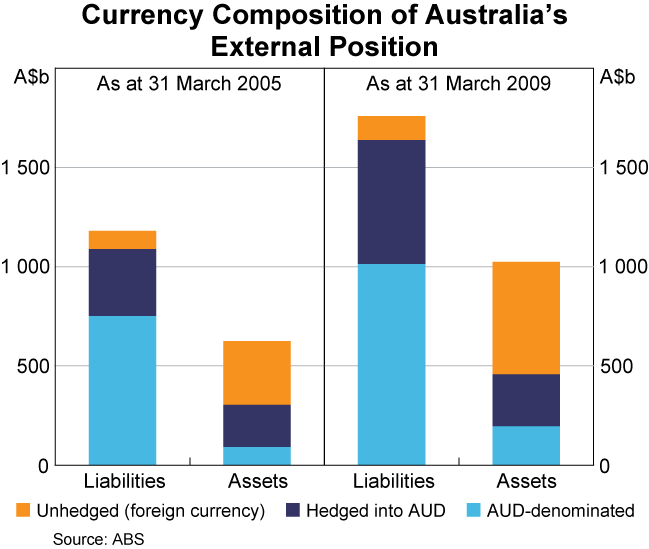
| As at 31 March 2005 | As at 31 March 2009 | |||
|---|---|---|---|---|
| Before hedging | After hedging | Before hedging | After hedging | |
| Equity assets | 344 | 272 | 457 | 325 |
| Debt assets | 214 | 68 | 416 | 269 |
| Debt liabilities | −466 | −75 | −829 | −133 |
| Net balance sheet exposure | 92 | 266 | 44 | 461 |
| Net trade exposure | 4 | 4 | 57 | 68 |
| Residual derivative position | −52 | −141 | ||
| Net exposure | 96 | 218 | 101 | 388 |
| Memo item | ||||
| Reported derivative position | 122 | 288 | ||
|
(a) Positive values represent holdings of foreign currency assets or derivative
positions under which the holder will receive foreign currency in exchange
for Australian dollars at a predetermined exchange rate (that is, a long
foreign currency/short AUD position). Negative values represent liabilities
denominated in foreign currency or derivative positions under which the
holder will receive Australian dollars in exchange for foreign currency
at a predetermined exchange rate (that is, a short foreign currency/long
AUD position). Sources: ABS; RBA |
||||
As a ratio to GDP, Australia's net foreign currency asset position rose by 6 percentage points between 2005 and 2009 to reach 32 per cent of GDP. This increase was more than fully accounted for by the accumulation of unhedged foreign currency debt assets. Foreign equity assets grew by less than GDP over the period (partly owing to the sharp decline in global equity markets in 2008) and hence subtracted from the ratio of foreign currency assets to GDP. As foreign currency debt liabilities are mostly hedged into Australian dollars, the growth in foreign liabilities had only a minimal effect on the aggregate foreign currency asset position. An increase in expected net foreign currency receipts from trade also made a modest contribution to the increase, while the residual derivative position (which captures both outright derivative positions unrelated to hedging and any measurement error[3]) declined substantially between the two surveys.
Foreign Currency Derivative Hedges
The hedging of foreign currency exposures using derivatives involves holding derivative contracts to offset the exchange rate exposure of the underlying instruments. For example, to hedge a net liability position in foreign currency (which can be described as a ‘short foreign currency/long AUD’ exposure) Australian borrowers enter derivative contracts under which they will receive foreign currency in exchange for Australian dollars at a predetermined exchange rate at the maturity of the contract (a ‘long foreign currency/short AUD’ derivative position). Hedges for foreign currency asset exposures involve taking a short foreign currency position in derivative markets.
The total gross foreign currency derivative positions reported in the survey are significantly larger than the total amount of hedging reported (Table 2). For example, the gross long foreign currency derivative position of $1.5 trillion is around double the amount of foreign liabilities hedged. This reflects the fact that banks hold large offsetting gross derivative positions, owing to the role they play as intermediaries in the derivative market, and because closing out positions in over-the-counter derivative markets typically requires writing an offsetting contract. Nevertheless, consistent with Australian entities hedging more foreign currency liability exposures than asset exposures, in aggregate there is a net long foreign currency position in derivatives of $288 billion. Although a significant portion of outstanding hedge positions are offsetting trades between residents, the net position, representing residents' net liability hedges, is ultimately with non-resident counterparties.
| Counterparty | Long foreign currency/short AUD positions | Short foreign currency/long AUD positions | Net positions |
|---|---|---|---|
| Resident | 554 | −554 | 0 |
| Non-resident | 991 | −703 | 288 |
| Total | 1,545 | −1,257 | 288 |
|
(a) Positive values represent derivative positions under which the holder will receive foreign currency in exchange for Australian dollars at a predetermined exchange rate (that is, a long foreign currency/short AUD position). Negative values represent derivative positions under which the holder will receive Australian dollars in exchange for foreign currency at a predetermined exchange rate (that is, a short foreign currency/long AUD position). Source: ABS |
|||
The immediate non-resident counterparties to derivative contracts are typically international banks acting as market makers who usually offset their exposure by providing a hedge to other non-residents, such as large foreign institutions that issue Australian dollar debt (and need to swap the proceeds into foreign currency). Foreign institutions issuing Australian dollar debt in Australia (‘Kangaroo issuers’) typically do not require Australian dollar funding, but find it cost effective to issue Australian dollar debt and swap the proceeds into foreign currency with an Australian counterparty – such as a bank – which has raised foreign currency debt but requires Australian dollar funds. Although market makers usually intermediate these trades, essentially the foreign issuer agrees to provide foreign currency to the Australian bank at a predetermined exchange rate at a specified date in the future, and vice versa, via a cross-currency basis swap.
These hedging trades are ultimately possible because foreign investors are willing to hold Australian dollar assets, or Australian dollar exposure through derivatives, as part of their portfolios. In essence, the existence of the hedging market and the willingness of international investors to purchase foreign currency debt from Australian entities and Australian dollar debt from foreign issuers allow Australian entities to borrow in domestic currency in international credit markets. Of the total Australian dollar debt issued by foreign entities, more than half is held by international investors.[4] Foreigners also hold Australian dollar exposures directly as outright derivative positions. In this case the foreign bank providing the hedge to an Australian resident typically passes the exposure to a customer, such as a hedge fund, seeking Australian dollar exposure via the derivatives market.
In total, foreigners' net Australian dollar exposure is around $1 trillion. Around $700 billion of this is direct exposure through holdings of the Australian dollar equity and debt liabilities of Australian entities (net of the small amount of foreigners' Australian dollar liabilities held by residents; refer Graph 1). The remainder is the $288 billion net long Australian dollar derivative position non-residents hold with Australians. Overall, foreigners' net Australian dollar exposure is small in the context of global investors' total portfolios.
Sectoral Results
As in 2001 and 2005, the sectoral results for the latest survey indicate that the aggregate foreign currency asset position is principally held by non-bank financial corporations (‘other financials’) and non-financial corporations (‘other residents’). The banking sector also has a small net foreign currency asset position, as do the government sector and the Reserve Bank (Table 3). This section discusses the foreign currency structure of each sector's external position in more detail.
| Banks | Other financials | Other residents | ||||
|---|---|---|---|---|---|---|
| Before hedging | After hedging | Before hedging | After hedging | Before hedging | After hedging | |
| Equity assets | 23 | 18 | 231 | 131 | 189 | 173 |
| Debt assets | 209 | 111 | 106 | 70 | 50 | 44 |
| Debt liabilities | −548 | −36 | −117 | −36 | −149 | −61 |
| Net balance sheet exposure | −317 | 92 | 220 | 165 | 90 | 156 |
| Net trade exposure | – | – | 1 | 1 | 56 | 66 |
| Residual derivative position | – | −54 | – | −12 | – | −72 |
| Net position | −317 | 38 | 221 | 154 | 146 | 150 |
| Memo item | ||||||
| Reported derivative position | 355 | −67 | 4 | |||
|
(a) See notes to Table 1 Sources: ABS, RBA |
||||||
Banks
The banking sector reports a small positive foreign currency position after hedging, despite continued growth since the previous survey in the sector's foreign currency liabilities. Banks account for around two-thirds of Australia's total foreign currency liabilities as a result of their use of global debt markets as a funding source. The high credit ratings and financial sophistication of Australian banks mean they are well placed to intermediate funds between international debt markets and domestic borrowers: they are consistently able to take advantage of the small pricing differentials between alternative funding markets and their central position in derivative markets to manage the associated exchange rate risks efficiently.[5] The fact that the profitability of Australian banks was not adversely affected by the sharp depreciation in the Australian dollar in late 2008 is strong evidence that their foreign currency exposures are conservatively hedged.
The survey shows that Australian banks hedge 95 per cent of their foreign currency liabilities (Graph 2), so that their unhedged foreign currency liabilities are relatively small at $36 billion (around 1½ per cent of banks' total balance sheet liabilities). These unhedged liabilities are potentially fully hedged naturally as they are more than offset by the banks' unhedged foreign currency debt assets and foreign equity investments. After hedging, banks actually hold a small net foreign currency asset position. Foreign currency debt assets, including domestic banks' participation in international syndicated loans, have grown particularly rapidly since the previous survey to be around 10 per cent of all bank assets. On average, banks hedge around 50 per cent of these debt assets, while their foreign equity assets (primarily direct investments in foreign subsidiaries) are hedged at less than 20 per cent.
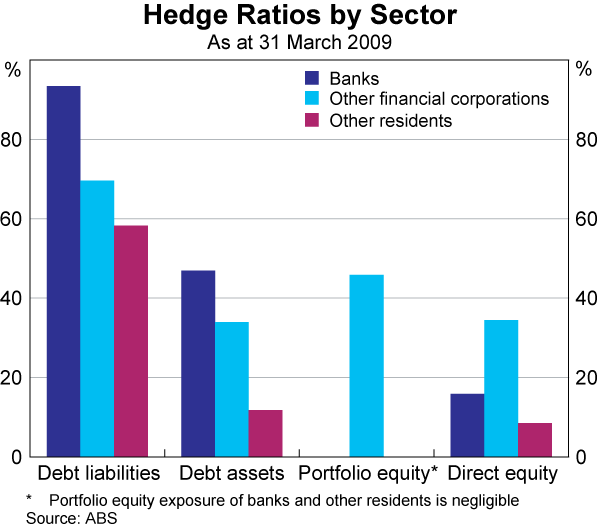
The survey also provides information on the maturity profiles of assets, liabilities and derivative positions. For the banks, the data indicate that hedges are generally maturity matched with the underlying exposure. On a net basis the liability position is more than fully offset by long foreign currency derivative positions for maturities of less than a year, fully offset for maturities of one to five years, and partially offset for net liabilities with a maturity beyond five years (Graph 3). The net short foreign currency position after hedging on long-dated debt reflects two main factors. First, as noted above, banks hold a small amount of unhedged liabilities, $36 billion, which the maturity data suggest are long-dated liabilities with a maturity beyond five years. Second, and consistent with the excess of foreign currency derivative hedges at short maturities, banks occasionally hedge long-maturity exposures by rolling forward short-dated hedges to take advantage of better liquidity and pricing in short-dated derivative markets. Although this exposes banks to some ‘basis risk’ in the repricing of the hedge premiums on the rolling of these hedges, it nonetheless means that they will be provided with foreign currency at a pre-agreed exchange rate at the maturity of the hedge. Even if a bank does not roll these hedges, it will nevertheless have received the foreign currency required to retire the foreign currency debt when the obligation is due.
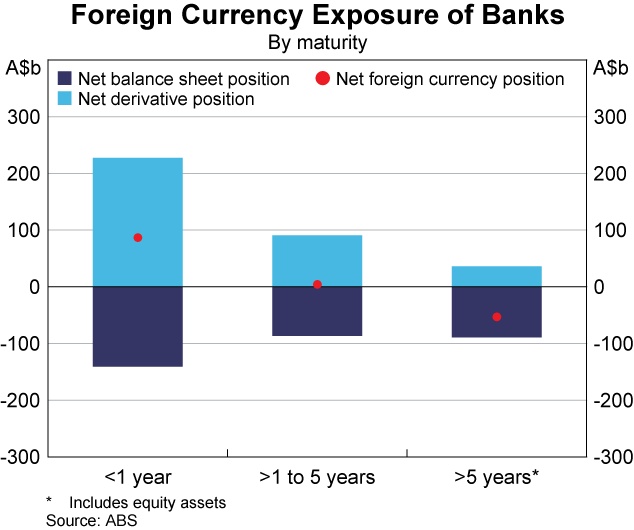
Non-bank financial corporations (‘other financials’)
‘Other financials’ is a heterogeneous sector consisting of superannuation funds and funds managers, which hold assets on behalf of households, and finance and insurance firms. As at March 2009, this group held a large positive foreign currency asset position of around $150 billion after hedging, which accounts for about 40 per cent of Australia's net foreign currency asset position. This net exposure is around 7 per cent of the sector's total assets, which is slightly higher than in 2005.
The bulk of the asset position is due to the sector's large holdings of foreign equities, for which the average hedge ratio is around 50 per cent. The sector also holds significant foreign currency debt assets, which include both the international bond portfolios of superannuation funds and the foreign currency loans of finance companies. Somewhat surprisingly, the survey results indicate that the average hedge ratio for these debt assets, at around 30 per cent, is less than the hedge ratio for equity assets.[6] The ABS advises that while superannuation funds tend to hedge their foreign bond portfolios more than their equity portfolios, the foreign currency debt assets of finance and insurance firms, which account for more than half the sector's foreign currency debt assets, are typically unhedged. These entities are often part of transnational groups and so the local exposures are not always hedged with derivatives but instead are managed as part of a global portfolio at the parent entity level.
Also included in this sector are the foreign currency asset-backed securities issued offshore by securitisation vehicles, which amount to almost $120 billion. The bulk of these are hedged into Australian dollars.
The maturity profiles of balance sheet exposures and derivative positions for other financials are less directly matched than for banks (Graph 4). This is because of the extensive use of short-dated derivatives to hedge the foreign exchange risk in international equity portfolios with indefinite investment horizons. The regular rolling forward of hedges allows fund managers to adjust the size of hedges dynamically in line with fluctuations in the underlying value of portfolios owing to movements in equity prices.
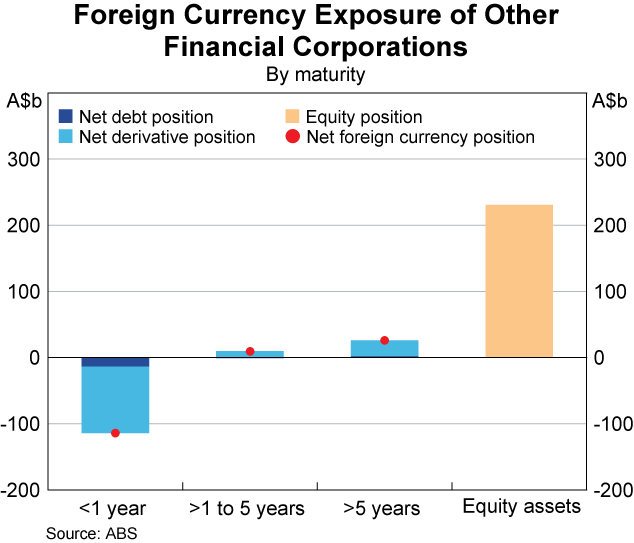
Non-financial corporations (‘other residents’)
Non-financial corporations, which hold most of the ‘other residents’ sector's foreign currency exposures, are significant holders of foreign currency assets: $173 billion in unhedged foreign equity assets and $44 billion in unhedged foreign currency debt assets. These companies have substantial foreign direct investments in offshore operations, including loans to foreign affiliates, which are rarely hedged with derivatives. Larger non-financial corporations also borrow directly in foreign debt markets which they hedge using derivatives at a lower hedge ratio than financial corporations (refer to Graph 2).
The relatively low use of hedging with derivatives partly reflects the greater use of natural hedging by non-financial corporations: to some degree non-financial firms actually seek foreign currency funding as a hedge against the exchange rate exposure in their offshore operations. Nonetheless, even allowing for natural hedging, non-financial firms hold significant unhedged foreign currency asset exposures. Although these asset exposures account for a large share of Australia's aggregate foreign currency asset position, they account for only 5?per?cent of the sector's total assets. Some non-financial firms likely retain the foreign currency exposures associated with offshore operations for the additional diversification benefit this provides. For importing firms with domestic operations that are particularly sensitive to the exchange rate, the exchange rate exposure of offshore operations can be a key source of diversification.
Trade-related foreign currency exposures are uniquely significant for the non-financial sector. Before hedging, expected foreign currency receipts from trade exceed payments by around $60 billion. The net long position in foreign currency is increased further after hedging to $70 billion (Graph 5), as importers report hedging a greater proportion of payments (27 per cent) than exporters hedge receivables (17 per cent). Note, however, that the size of the residual position for this sector suggests some uncertainty around the hedging ratios estimates for trade receipts and payments.
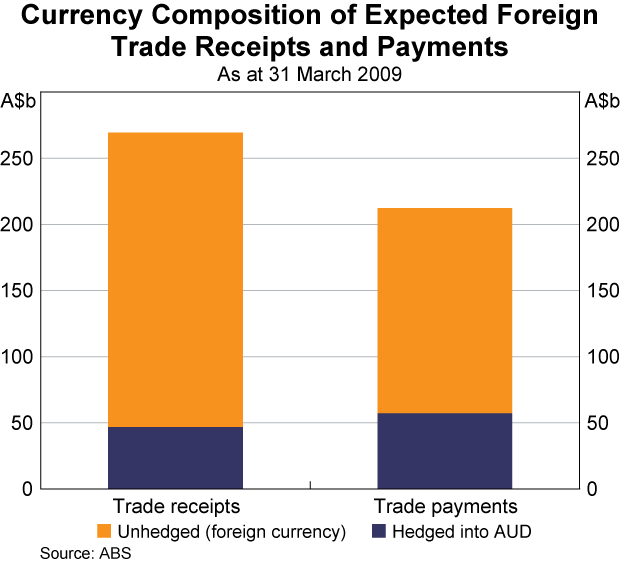
Reserve Bank of Australia
The Reserve Bank's foreign currency asset position represents the $44 billion of US dollar, euro and yen assets held outright as official reserves as at the end of March 2009 (Table 4). This is considerably larger than the Bank's outright holding of reserve assets in 2005 and is the result of the accumulation of reserves over a period when the Australian currency was mostly appreciating. As reserve assets are purchased outright, and held for the purpose of intervening in the foreign exchange market, they are not hedged. Unlike at the time of the 2005 survey, when the Reserve Bank was holding a larger than usual amount of foreign exchange under swap as part of its domestic liquidity operations, at the time of the 2009 survey the Bank's foreign exchange derivative position was negligible.[7]
| Reserve Bank | Government | |||
|---|---|---|---|---|
| Before hedging | After hedging | Before hedging | After hedging | |
| Equity assets | 0 | 0 | 14 | 3 |
| Debt assets | 44 | 44 | 7 | 1 |
| Debt liabilities | 0 | 0 | −14 | −2 |
| Net balance sheet exposure | 44 | 44 | 7 | 3 |
| Net trade exposure | – | – | 0 | – |
| Residual derivative position | – | −1 | – | 1 |
| Net position | 44 | 43 | 7 | 3 |
| Memo item | ||||
| Reported derivative position | −1 | −4 | ||
|
(a) See notes to Table 1 Sources: ABS, RBA |
||||
General Government and Central Borrowing Authorities
The net foreign currency position of the government sector is relatively small at around $3 billion and is little changed from the last survey. However, the net figure disguises growth in the underlying asset and liability positions. The sector has foreign currency liabilities of $14 billion, largely accounted for by liabilities of the State borrowing authorities, which are almost fully hedged into Australian dollars. On the asset side, the Australian Government's Future Fund holds over $20 billion in foreign equity and debt assets, which are 80 per cent hedged.
Currency Composition
For Australia as a whole, the US dollar accounts for almost 60 per cent of total foreign currency exposures. Other major exposures are in euro (14 per cent of total exposures), pound sterling (7 per cent) and yen (6 per cent). The currency profile of derivative exposures follows a similar pattern, with almost 80 per cent of foreign currency derivatives denominated in US dollar terms. The survey results indicate that the net foreign currency asset position after hedging is largely US-dollar denominated.
Gross Foreign Exchange Derivative Instruments
As noted above, the survey indicates that gross holdings of foreign exchange derivatives are much larger than the underlying foreign currency asset and liability positions, partly owing to offsetting derivative trades undertaken by banks acting as market intermediaries (Table 5). The banks also account for the bulk of the aggregate net position in derivative contracts, with a net long foreign currency derivative position of $355 billion, while the positions of the other sectors net to a relatively small short position of $67 billion. This is not surprising given that banks account for the bulk of total net foreign currency liabilities and thus must also hold the offsetting derivative positions to hedge this exposure.
| Long foreign currency/short AUD positions | Short foreign currency/long AUD positions | Net positions | |
|---|---|---|---|
| Total | 1,545 | −1,257 | 288 |
| By instrument: | |||
| Forward foreign exchange | 730 | −749 | −19 |
| Cross-currency interest rate swaps | 621 | −349 | 272 |
| Futures | 99 | −97 | 1 |
| Currency options | 49 | −45 | 5 |
| Other | 46 | −17 | 29 |
| By sector: | |||
| Banks | 1,274 | −919 | 355 |
| All others | 271 | −338 | −67 |
|
(a) See notes to Table 2 Source: ABS |
|||
The prominence of the banks is also evident in the breakdown of the derivative data by instrument type. Reflecting the netting of offsetting trades among residents, the net positions for Australian residents in aggregate are relatively small for most instruments. The exception is cross-currency interest rate swaps, which are the primary instrument used to hedge long-term debt positions and account for most of the banks' net long foreign currency position in derivatives. Nevertheless, the most widely held hedging instruments are forwards, which are typically used to hedge equity and trade-related foreign exchange exposures.
Summary
The 2009 survey of foreign currency exposure indicates that Australian institutions remain well hedged against the risk of sharp movements in the exchange rate. Australia's foreign currency debt liabilities are essentially fully hedged into Australian dollars using derivative instruments, with the small amount of unhedged liabilities largely held as natural hedges. This is most evident for the banking sector which accounts for the bulk of foreign currency debt liabilities and hedges almost all of these liabilities with derivatives. Australia's net foreign currency exposure arises from holdings of unhedged foreign currency assets. This net foreign currency asset exposure is mostly held by superannuation funds and insurance firms or as the direct foreign investments of non-financial corporations. In both cases these exposures are long-term investments held for portfolio diversification purposes. In aggregate, Australia has a foreign currency asset position despite having large net foreign liabilities. This is possible because non-residents are willing to hold Australian dollar exposure as part of their portfolios, not only through direct holdings of Australian dollar assets, but also as counterparties to derivative contracts.
Footnotes
This article was prepared by Patrick D'Arcy and Muhummed Shah Idil of International Department and Tim Davis of Domestic Markets Department. [1]
See Foreign Currency Exposure, ABS Cat No 5308.0, March Quarter 2009. The three surveys have been conducted by the ABS with the support of the Reserve Bank. The previous survey is discussed in Becker C, G Debelle and D Fabbro (2005), ‘Australia's Foreign Currency Exposure and Hedging Practices’, RBA Bulletin, December, pp 1–8. See also Becker C and D Fabbro (2006), ‘Limiting Foreign Exchange Exposure through Hedging: The Australian Experience’, RBA Research Discussion Paper No 2006-09. [2]
The measurement error captured by the residual derivative position in Table 1 was larger in 2009 than in 2005 owing to the sharp depreciation in the exchange rate in late 2008 in the lead-up to the 2009 survey. The exchange rate movement changes the market value of underlying exposures and the implicit size of the hedge based on reported hedge ratios, but this is corrected for in the table since the residual derivative position uses data from the survey on the actual net derivative position. [3]
Total outstanding Australian dollar bond issuance by foreign entities is around $160 billion. Around $100 billion of this comprises Kangaroo bonds issued in Australia with the remainder issued offshore. Foreign investors hold around $30 billion of Kangaroo issuance outstanding and the bulk of offshore Australian dollar issuance. [4]
See RBA (2006), ‘Australian Banks' Global Bond Funding’, RBA Bulletin, August, pp 1–6. [5]
The NAB Superannuation FX Survey, conducted in April 2009, reports that superannuation funds hedge the exchange rate risk in foreign equity portfolios at 50 per cent and in debt portfolios at 90 per cent. The NAB survey covers 34 of Australia's largest superannuation funds, representing 60 per cent of total assets under management. [6]
For a brief discussion of the reasons for the unwinding of the Reserve Bank's foreign exchange swap book in 2007, see D'Arcy P and C Ossolinski (2009), ‘Australian Capital Flows and the Financial Crisis’, RBA Bulletin, November, pp 1–6. [7]